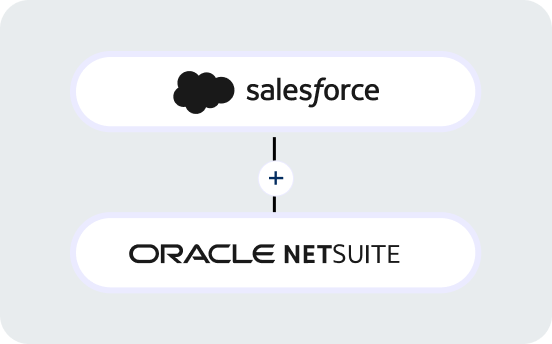Improving Sales Team experiences with integrations

How integrations benefit sales teams
Integrations can enhance lead generation, improve customer relationship management, streamline sales processes, automate repetitive tasks, gain data-driven insights, and ultimately close deals more effectively. Integrations help sales teams maximize their productivity, deliver better customer experiences, and drive revenue growth.
Initus can resolve sales team challenges via integrations
The challenges
The solutions
01 – Disconnected CRM and Sales Tools: Sales teams often struggle with disconnected customer relationship management (CRM) systems and sales tools. This leads to duplicate data entry, inconsistent customer information, and inefficiencies in managing and tracking sales activities and customer interactions.
02 – Lack of Sales Data Visibility: Without integrations, sales teams may lack real-time visibility into sales data. This hampers their ability to track sales performance, monitor pipeline progress, and make data-driven decisions. This lack of visibility can result in missed opportunities, delayed sales cycles, and decreased productivity.
03 – Manual Sales Processes: When systems are not integrated, sales teams often rely on manual processes such as manual data entry, report generation, and order processing. This leads to errors, delays, and a loss of valuable selling time, ultimately impacting sales effectiveness and agility.
04 – Inefficient Lead Management: Disconnected systems make it challenging for sales teams to effectively manage leads and convert them into customers. Manual lead routing, lack of lead scoring automation, and poor visibility into lead status can result in missed opportunities, slow response times, and inconsistent lead nurturing.
05 – Inconsistent Sales and Warehouse Alignment: Lack of system integrations can create misalignment between the sales and warehouse teams. Disconnected data, such as ready-to-fulfill orders, available inventory, and shipping information, can lead to discrepancies, miscommunication, and ineffective collaboration between the two teams.
01 – Seamless CRM and Sales Tool Integration: Integrating CRM systems with sales tools enables sales teams to have a unified view of customer data, sales activities, and pipeline progress. This eliminates duplicate data entry, improves data accuracy, and enhances efficiency in managing sales processes.
02 – Real-time Sales Analytics: Integrations provide sales teams with real-time visibility into sales data. This enables sales representatives and managers to track key performance metrics, analyze pipeline health, and make informed decisions to drive revenue growth and sales success.
03 – Automated Sales Processes: Integrations automate manual sales processes, such as data entry, report generation, and order processing. This streamlines workflows, reduces errors, and frees up sales professionals’ time to focus on selling, ultimately improving productivity and responsiveness.
04 – Enhanced Lead Management: With integrations, sales teams can automate lead routing, scoring, and qualification processes. This ensures quick and accurate lead handling, improves lead nurturing and conversion rates, and enhances overall lead management effectiveness.
05 – Improved Sales and Warehouse Alignment: By integrating sales and warehouse systems, teams can have synchronized data and improve collaboration. Shared visibility into data such as inventory availability, ready-to-ship orders, and customer data interactions facilitates better alignment, leading to consistent messaging, targeted warehouse efforts, and improved sales and warehouse team collaboration.
The challenge
01 – Disconnected CRM and Sales Tools: Sales teams often struggle with disconnected customer relationship management (CRM) systems and sales tools. This leads to duplicate data entry, inconsistent customer information, and inefficiencies in managing and tracking sales activities and customer interactions.
02 – Lack of Sales Data Visibility: Without integrations, sales teams may lack real-time visibility into sales data. This hampers their ability to track sales performance, monitor pipeline progress, and make data-driven decisions. This lack of visibility can result in missed opportunities, delayed sales cycles, and decreased productivity.
03 – Manual Sales Processes: When systems are not integrated, sales teams often rely on manual processes such as manual data entry, report generation, and order processing. This leads to errors, delays, and a loss of valuable selling time, ultimately impacting sales effectiveness and agility.
04 – Inefficient Lead Management: Disconnected systems make it challenging for sales teams to effectively manage leads and convert them into customers. Manual lead routing, lack of lead scoring automation, and poor visibility into lead status can result in missed opportunities, slow response times, and inconsistent lead nurturing.
05 – Inconsistent Sales and Warehouse Alignment: Lack of system integrations can create misalignment between the sales and warehouse teams. Disconnected data, such as ready-to-fulfill orders, available inventory, and shipping information, can lead to discrepancies, miscommunication, and ineffective collaboration between the two teams.
The solutions
01 – Seamless CRM and Sales Tool Integration: Integrating CRM systems with sales tools enables sales teams to have a unified view of customer data, sales activities, and pipeline progress. This eliminates duplicate data entry, improves data accuracy, and enhances efficiency in managing sales processes.
02 – Real-time Sales Analytics: Integrations provide sales teams with real-time visibility into sales data. This enables sales representatives and managers to track key performance metrics, analyze pipeline health, and make informed decisions to drive revenue growth and sales success.
03 – Automated Sales Processes: Integrations automate manual sales processes, such as data entry, report generation, and order processing. This streamlines workflows, reduces errors, and frees up sales professionals’ time to focus on selling, ultimately improving productivity and responsiveness.
04 – Enhanced Lead Management: With integrations, sales teams can automate lead routing, scoring, and qualification processes. This ensures quick and accurate lead handling, improves lead nurturing and conversion rates, and enhances overall lead management effectiveness.
05 – Improved Sales and Warehouse Alignment: By integrating sales and warehouse systems, teams can have synchronized data and improve collaboration. Shared visibility into data such as inventory availability, ready-to-ship orders, and customer data interactions facilitates better alignment, leading to consistent messaging, targeted warehouse efforts, and improved sales and warehouse team collaboration.
Start shaping the future of your business
Today is a great day to optimize your
Sales Operations Audit Process e-Commerce Channel Data Migration Project Procurement Process Inventory Management
with Initus

Our Pre-Built Solution
No more excuses
Maximize the potential of your sales team and financial department with the seamless integration of Salesforce and Netsuite.
Streamline your lead management, order processing and financial tracking processes.
Designed for Simplicity, Built for Power
Whether you need standard integrations or want to tap into the power of AI, InitusIO offers a complete solution. What sets us apart? Our seamless setup, expert support, and ability to handle both regular and AI-enhanced integrations with ease.

Tailored for Your Business
We assess your unique needs and design integrations to drive efficiency in the processes that matter most.

Quick and Seamless Integration
Skip the complexities—our turnkey solution is built for fast, seamless deployment.

Scalable and Secure
InitusIO grows with your business, ensuring scalability and security at every step.
